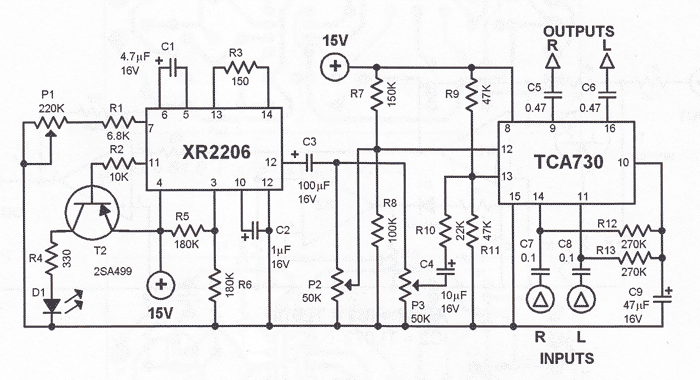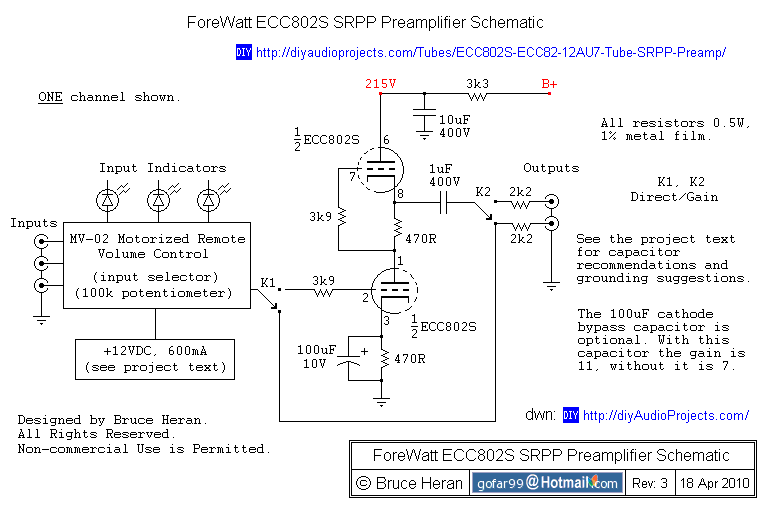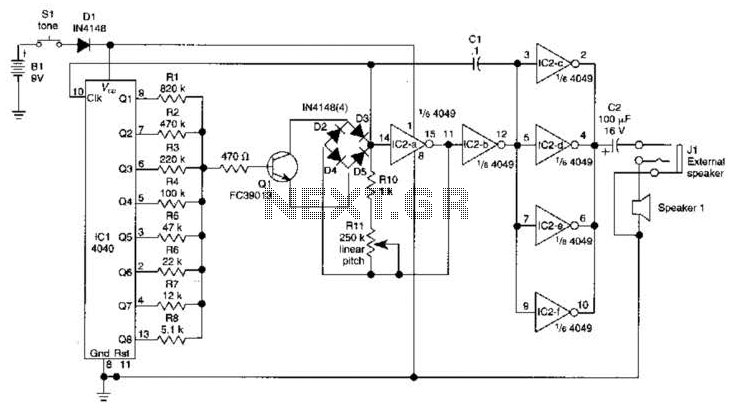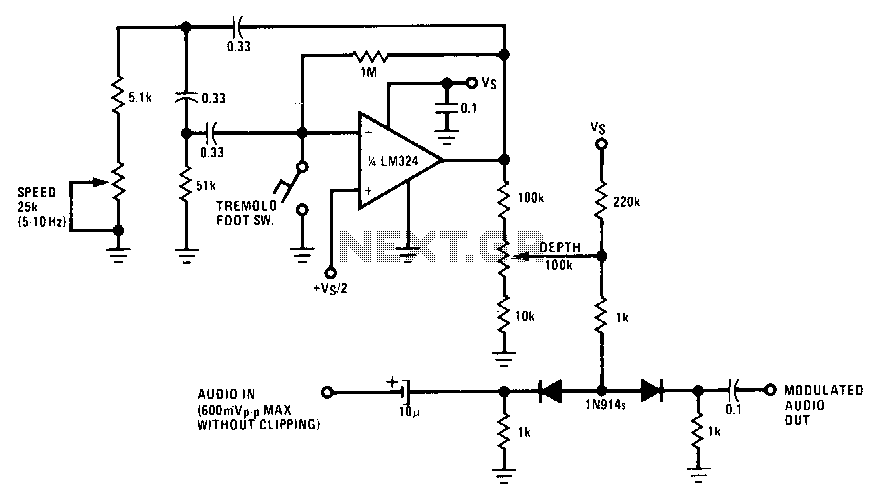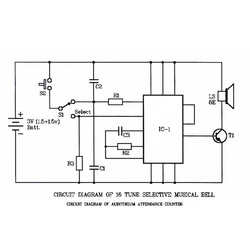
DIY Tremolo Effect
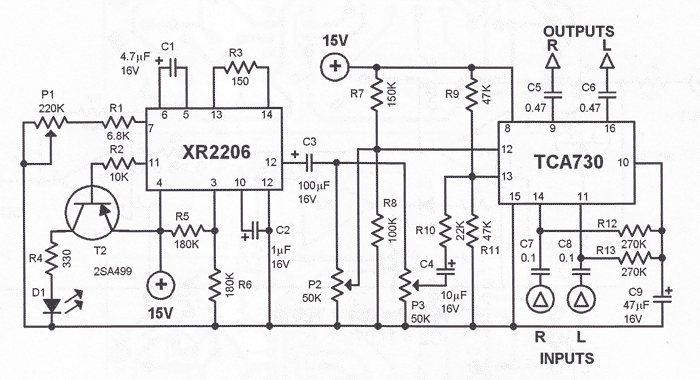
This tremolo effect circuit utilizes the XR2206 and TCA730 integrated circuits, designed for electronic balance and volume regulation with frequency correction. It is suitable for stereo channels and can simulate the Lesley effect, also known as the rotating loudspeaker effect. The tremolo effect circuit operates by adjusting balance and volume settings using a linear potentiometer for both channels. If this potentiometer is replaced with an AC voltage source, periodic modulation of the input signal can be achieved. The AC voltage source is provided by the function generator IC XR2206, which generates square, triangle, and sine wave signals; however, only the sine wave is used in this project. The modulation voltage can be adjusted with potentiometer P1, ranging from 1 Hz to 25 Hz. Resistor R3 establishes the operational level of the sine wave generator, while resistors R5 and R6 determine the DC voltage and sine wave amplitude at the output. Capacitor C2 acts as a ripple filter. The square wave output from the XR2206 drives transistor T2 and an LED that visually indicates the frequency. The modulating voltage is sent to pin 13 of the TCA730 through potentiometer P3 and resistor R10, serving as the volume control or volume modulation in this context. The extent of balance modulation, contributing to the Lesley effect, can be adjusted using potentiometer P2. A regulated power supply using the 7815 IC is recommended, as a non-stabilized power supply could negatively affect modulation due to current fluctuations. It is advised to attach the 7815 IC to an adequate heat sink, approximately 10 cm² in size.
This tremolo effect circuit offers a versatile platform for audio modulation, combining advanced components to create a rich sound experience. The XR2206 serves as the heart of the modulation process, generating precise sine wave signals that are crucial for achieving the desired tremolo effect. The choice of using a linear potentiometer allows for smooth adjustments in both balance and volume, facilitating user-friendly operation.
The integration of the TCA730 enhances the circuit's capability by providing effective volume control, allowing for dynamic sound modulation. The modulation range of 1 Hz to 25 Hz, adjustable via potentiometer P1, enables a wide variety of tremolo effects, making this circuit suitable for different musical styles. The ripple filter (C2) ensures that the output remains clean and free from unwanted noise, which is essential for maintaining audio fidelity.
The visual feedback provided by the LED connected to T2 is a valuable feature, allowing users to monitor the modulation frequency in real-time. This can be particularly beneficial in live performance settings, where quick adjustments may be necessary.
Overall, this tremolo effect circuit is designed for reliability and performance, with careful consideration given to power supply stability. The recommendation to use a regulated power supply with the 7815 IC ensures that the circuit operates consistently, preventing modulation issues that could arise from voltage fluctuations. The inclusion of a heat sink for the 7815 further enhances the circuit's durability, allowing it to handle extended use without overheating.This tremolo effect circuit uses the XR2206 and the TCA730 IC which is designed as an electronic balance and volume regulator with frequency correction. The circuit is use full for stereo channels and it also has the ability to simulate the Lesley effect aka rotating loudspeaker effect.
How does the tremolo effect circuit works Balance and volume settings are done with a linear potentiometer for both channels. If this potentiometer is replaced with an AC voltage source, a periodic modulation of the input signal can be achieved. This AC voltage source comes from the function generator IC XR2206. This IC generates square, triangle and sine wave signals but for this project we use only the sine wave.
The modulation voltage can be varied with P1 from 1 Hz up to 25 Hz. Resistor R3 sets the operation level of the sine wave generator. R5 and R6 set the DC voltage and the sine wave amplitude at the output. C2 is a ripple filter. The square wave output of the XR2206 drives T2 and a LED to optically display the frequency. The modulating voltage reaches pin 13 of TCA730 via P3 and R10. This input functions as the volume control or in this case the volume modulation. The degree of the balance modulation (Lesley effect) can be varied with P2. A regulated power supply using 7815 IC is recommended. Do not use a non-stabilized power supply since the current variations would influence the modulation negatively. Attach the 7815 IC to a good heat sink (about 10 cm2). 🔗 External reference
This tremolo effect circuit offers a versatile platform for audio modulation, combining advanced components to create a rich sound experience. The XR2206 serves as the heart of the modulation process, generating precise sine wave signals that are crucial for achieving the desired tremolo effect. The choice of using a linear potentiometer allows for smooth adjustments in both balance and volume, facilitating user-friendly operation.
The integration of the TCA730 enhances the circuit's capability by providing effective volume control, allowing for dynamic sound modulation. The modulation range of 1 Hz to 25 Hz, adjustable via potentiometer P1, enables a wide variety of tremolo effects, making this circuit suitable for different musical styles. The ripple filter (C2) ensures that the output remains clean and free from unwanted noise, which is essential for maintaining audio fidelity.
The visual feedback provided by the LED connected to T2 is a valuable feature, allowing users to monitor the modulation frequency in real-time. This can be particularly beneficial in live performance settings, where quick adjustments may be necessary.
Overall, this tremolo effect circuit is designed for reliability and performance, with careful consideration given to power supply stability. The recommendation to use a regulated power supply with the 7815 IC ensures that the circuit operates consistently, preventing modulation issues that could arise from voltage fluctuations. The inclusion of a heat sink for the 7815 further enhances the circuit's durability, allowing it to handle extended use without overheating.This tremolo effect circuit uses the XR2206 and the TCA730 IC which is designed as an electronic balance and volume regulator with frequency correction. The circuit is use full for stereo channels and it also has the ability to simulate the Lesley effect aka rotating loudspeaker effect.
How does the tremolo effect circuit works Balance and volume settings are done with a linear potentiometer for both channels. If this potentiometer is replaced with an AC voltage source, a periodic modulation of the input signal can be achieved. This AC voltage source comes from the function generator IC XR2206. This IC generates square, triangle and sine wave signals but for this project we use only the sine wave.
The modulation voltage can be varied with P1 from 1 Hz up to 25 Hz. Resistor R3 sets the operation level of the sine wave generator. R5 and R6 set the DC voltage and the sine wave amplitude at the output. C2 is a ripple filter. The square wave output of the XR2206 drives T2 and a LED to optically display the frequency. The modulating voltage reaches pin 13 of TCA730 via P3 and R10. This input functions as the volume control or in this case the volume modulation. The degree of the balance modulation (Lesley effect) can be varied with P2. A regulated power supply using 7815 IC is recommended. Do not use a non-stabilized power supply since the current variations would influence the modulation negatively. Attach the 7815 IC to a good heat sink (about 10 cm2). 🔗 External reference

